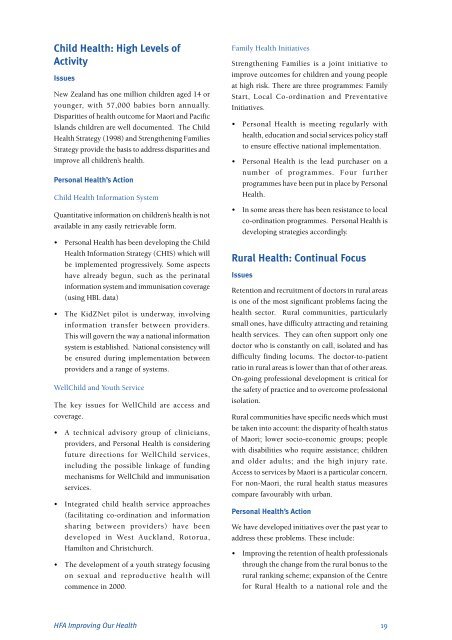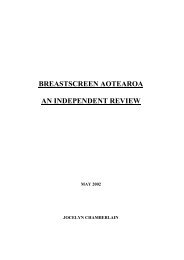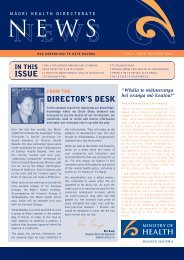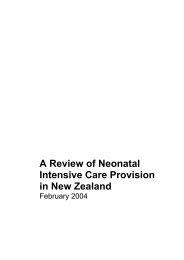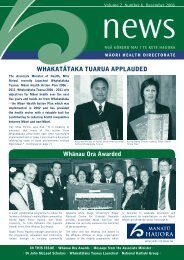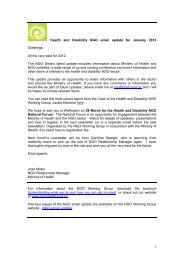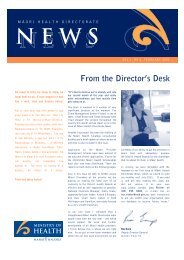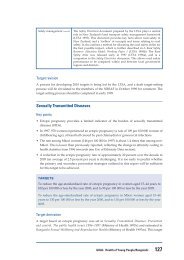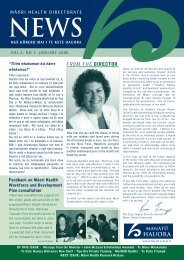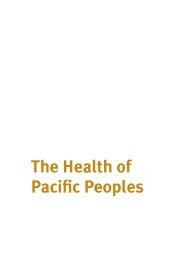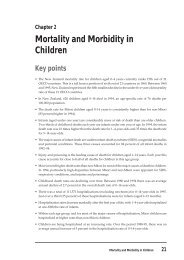Document for PDF - Ministry of Health
Document for PDF - Ministry of Health
Document for PDF - Ministry of Health
Create successful ePaper yourself
Turn your PDF publications into a flip-book with our unique Google optimized e-Paper software.
Child <strong>Health</strong>: High Levels <strong>of</strong><br />
Activity<br />
Issues<br />
New Zealand has one million children aged 14 or<br />
younger, with 57,000 babies born annually.<br />
Disparities <strong>of</strong> health outcome <strong>for</strong> Maori and Pacific<br />
Islands children are well documented. The Child<br />
<strong>Health</strong> Strategy (1998) and Strengthening Families<br />
Strategy provide the basis to address disparities and<br />
improve all children’s health.<br />
Personal <strong>Health</strong>’s Action<br />
Child <strong>Health</strong> In<strong>for</strong>mation System<br />
Quantitative in<strong>for</strong>mation on children’s health is not<br />
available in any easily retrievable <strong>for</strong>m.<br />
• Personal <strong>Health</strong> has been developing the Child<br />
<strong>Health</strong> In<strong>for</strong>mation Strategy (CHIS) which will<br />
be implemented progressively. Some aspects<br />
have already begun, such as the perinatal<br />
in<strong>for</strong>mation system and immunisation coverage<br />
(using HBL data)<br />
• The KidZNet pilot is underway, involving<br />
in<strong>for</strong>mation transfer between providers.<br />
This will govern the way a national in<strong>for</strong>mation<br />
system is established. National consistency will<br />
be ensured during implementation between<br />
providers and a range <strong>of</strong> systems.<br />
WellChild and Youth Service<br />
The key issues <strong>for</strong> WellChild are access and<br />
coverage.<br />
• A technical advisory group <strong>of</strong> clinicians,<br />
providers, and Personal <strong>Health</strong> is considering<br />
future directions <strong>for</strong> WellChild services,<br />
including the possible linkage <strong>of</strong> funding<br />
mechanisms <strong>for</strong> WellChild and immunisation<br />
services.<br />
• Integrated child health service approaches<br />
(facilitating co-ordination and in<strong>for</strong>mation<br />
sharing between providers) have been<br />
developed in West Auckland, Rotorua,<br />
Hamilton and Christchurch.<br />
• The development <strong>of</strong> a youth strategy focusing<br />
on sexual and reproductive health will<br />
commence in 2000.<br />
Family <strong>Health</strong> Initiatives<br />
Strengthening Families is a joint initiative to<br />
improve outcomes <strong>for</strong> children and young people<br />
at high risk. There are three programmes: Family<br />
Start, Local Co-ordination and Preventative<br />
Initiatives.<br />
• Personal <strong>Health</strong> is meeting regularly with<br />
health, education and social services policy staff<br />
to ensure effective national implementation.<br />
• Personal <strong>Health</strong> is the lead purchaser on a<br />
number <strong>of</strong> programmes. Four further<br />
programmes have been put in place by Personal<br />
<strong>Health</strong>.<br />
• In some areas there has been resistance to local<br />
co-ordination programmes. Personal <strong>Health</strong> is<br />
developing strategies accordingly.<br />
Rural <strong>Health</strong>: Continual Focus<br />
Issues<br />
Retention and recruitment <strong>of</strong> doctors in rural areas<br />
is one <strong>of</strong> the most significant problems facing the<br />
health sector. Rural communities, particularly<br />
small ones, have difficulty attracting and retaining<br />
health services. They can <strong>of</strong>ten support only one<br />
doctor who is constantly on call, isolated and has<br />
difficulty finding locums. The doctor-to-patient<br />
ratio in rural areas is lower than that <strong>of</strong> other areas.<br />
On-going pr<strong>of</strong>essional development is critical <strong>for</strong><br />
the safety <strong>of</strong> practice and to overcome pr<strong>of</strong>essional<br />
isolation.<br />
Rural communities have specific needs which must<br />
be taken into account: the disparity <strong>of</strong> health status<br />
<strong>of</strong> Maori; lower socio-economic groups; people<br />
with disabilities who require assistance; children<br />
and older adults; and the high injury rate.<br />
Access to services by Maori is a particular concern.<br />
For non-Maori, the rural health status measures<br />
compare favourably with urban.<br />
Personal <strong>Health</strong>’s Action<br />
We have developed initiatives over the past year to<br />
address these problems. These include:<br />
• Improving the retention <strong>of</strong> health pr<strong>of</strong>essionals<br />
through the change from the rural bonus to the<br />
rural ranking scheme; expansion <strong>of</strong> the Centre<br />
<strong>for</strong> Rural <strong>Health</strong> to a national role and the<br />
HFA Improving Our <strong>Health</strong> 19


